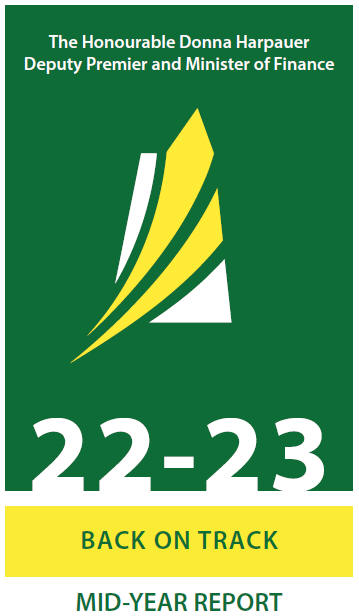EXPENSE UPDATE
At mid-year, expense is forecast to be $18.4 billion, an increase of $795.0 million (4.5 per cent) from budget and $286.8 million (1.6 per cent) from first quarter. The increase is primarily due to the one-time affordability payment to individuals as well as higher expense for Crop Insurance indemnities and AgriStability benefits.
Economic Development is up $475.1 million, mainly due to $450 million for the one-time Saskatchewan Affordability Tax Credit payment and lands sale fees and development costs of $18 million at the Global Transportation Hub Authority.
Agriculture increased $204.3 million, reflecting increases in Saskatchewan Crop Insurance Corporation indemnities of $147 million and $57 million in expected AgriStability benefits for 2021 and 2022.
Protection of Persons and Property is up $61.9 million, primarily due to a $42.7 million increase in expenses at the Saskatchewan Public Safety Agency for exported fire services, wildfire, search and rescue, and flooding costs, support for Ukraine and maintenance and repairs for the aerial fleet. There is also an increase of $19.2 million in the Ministry of Corrections, Policing and Public Safety for the Provincial Disaster Assistance Program due to severe weather, and at correctional facilities for overtime related to high inmate counts, and Royal Canadian Mounted Police costs related to the James Smith Cree Nation tragedy.
Health is forecast to increase $61.4 million, including $41.4 million for utilization pressures in the Saskatchewan Prescription Drug Plan and $20 million for the Saskatchewan Health Authority due to higher-than-budgeted health system expenditures.
Community Development increased $17.6 million, mainly due to a $12.4 million increase for payments to the First Nations Trusts and Community Development Corporations for gaming profits generated during the pandemic. There is also an $11.7 million increase for transit and housing supports, not incorporated in the budget (with an offsetting increase in federal revenue that was reflected in the first quarter forecast).
Financing Charges are up $200,000 primarily due to higher interest rates, offset by reduced borrowing costs from paying down debt.
Environment and Natural Resources is down $14.1 million, mainly due to changes in timing of uptake between fiscal years for the Accelerated Site Closure Program.
General Government costs decreased by $7.2 million, reflecting lower actuarial losses on pensions and changes in interest rates.
Education is down $4.1 million primarily due to a combination of lower pension costs, vacancy management and child care program underutilization, that are partially offset by increases to the boards of education for costs including maintenance, fuel, insurance and student enrolment pressures.
Social Services and Assistance and Transportation remain unchanged from budget.
PUBLIC DEBT UPDATE
At mid-year, Public debt is forecast to be $27.9 billion at March 31, 2023, which is $2.1 billion lower than budgeted.
This improvement is primarily due to a $2.2 billion decrease in General Revenue Fund (GRF) operating debt as a result of the significant improvements in the 2022-23 fiscal outlook. The return to surplus means $850.0 million of new operating borrowing, included at budget, is no longer necessary.
The strong fiscal picture and improved bottom line now forecast for 2022-23 also allows for retirement of up to $1 billion in existing debt, and it allows for the internal financing of $350.0 million of SaskPower’s borrowing requirements, reducing overall public debt.
There is a $131.0 million decrease in borrowing for the Saskatchewan Capital Plan, as some ministry and agency capital can be funded with cash from the surplus rather than issuing new debt.
Decreases are partially offset by GBE debt which is forecast to be $261.1 million higher than budgeted. This is largely due to $226.9 million in increased debt at SaskPower, primarily due to increased fuel costs driven by higher natural gas prices and decreased availability of low-cost hydroelectric generation. SaskTel’s debt is forecast to be $56.4 million higher, primarily due to higher-than-anticipated capital spending last fiscal year, which resulted

